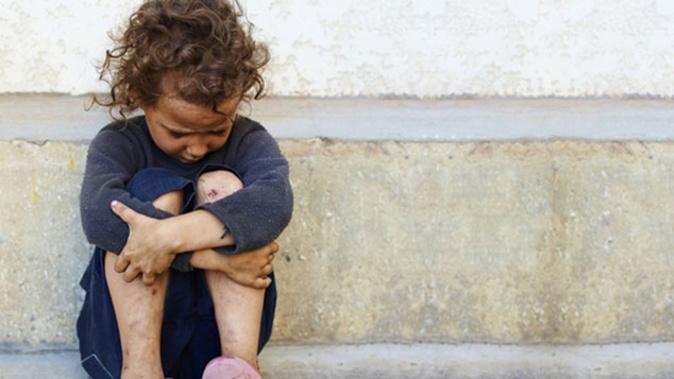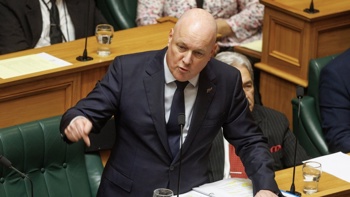
Top officials advised the Government it would cost $3 billion a year for New Zealand to reach the child poverty reduction target set by the last Government.
The Green Party says the Government should stump up with the cash and the advice proves that “poverty is a political choice”.
But Child Poverty Reduction Minister Louis Upston said this is a check she won’t be writing, and she will be working to reduce child poverty through other means.
An April Ministerial briefing from the Treasury reveals the Labour Government’s poverty targets were “no longer realistically achievable”.
In 2018, then-Child Poverty Reduction Minister Jacinda Ardern set a long-term goal of reducing the number of children experiencing “material hardship” from 13.3 percent down to 6 percent by mid 2028.
That’s a reduction of around 80,000 children between 2018 and 2028.
Ardern also set an intermediate target of 9 percent by June this year.
The latest data shows that target will be missed significantly; Statistics New Zealand figures show 12.5 percent of children – some 143,700 kids – are experiencing material hardship.
The previous Government points to factors such as the Covid-19 pandemic as reasons for missing the target.
Nevertheless, officials at the Department of Prime Minister and Cabinet (DPMC) advised that, given the Government is currently so far off achieving this year’s intermediate target of 9 percent, the long-term 6 percent target by mid 2028 was unrealistic.
“The necessary year-on-year progress is not on track and the estimated costs of now meeting these targets would require investment in the region of $3 billion per year,” officials advised, according to documents released under the Official Information Act.
They also presented two other “lower ambition targets” for 2028 – which they said were more realistic and could be achievable without spending more money.
But Upston’s office has confirmed the Minister rejected both options, which would have seen the current 6 percent material hardship target increase – likely to a figure closer to 10 percent.
However, she said the Government won’t be spending the extra $3 billion a year to achieve that 6 percent target that she said the Government was sticking to.
Instead, Upston believes a more effective way to lift children out of poverty is by growing the economy and cutting taxes.
She said the official advice was based on modelling of what would have needed to be spent, to carry on the previous Government’s child poverty approach, such as increasing benefits.
Meanwhile, Upston’s pointed the finger at Labour, over its inability to meet the child poverty targets that it set when it was in office.
“It left office with a growing number of families trapped by long-term welfare dependency, a growing number of children living in benefit-dependant homes, and low-to-middle income New Zealanders falling further behind due to the cost-of-living crisis that resulted from their economic mismanagement.”
Meanwhile, the Greens Child Poverty Reduction spokesperson Ricardo Menéndez March said the $3 billion price tag shows “poverty is a political choice”.
“A choice the current Government has chosen to preserve and prolong time and time again with decisions that put an already privileged few before essentially everyone else.”
He pointed out the cost of reinstating the full interest deductions for residential property – often described as landlords tax cut – was $2.9 billion.
“We can afford to end poverty, but we simply cannot afford to allow more and more children to fall through the cracks.”
Earlier this year, Upston reassessed the child poverty targets in line with legislation requiring the new Government to pick a new, intermediate target.
The previous Government had set a goal of reducing the number of children experiencing material hardship from 13.3 percent down to 9 percent by June this year.
The latest retrospective data from February shows12.5 percent of children are experiencing material hardship.
A child is experiencing material hardship if their household does not have six or more basic needs including: The ability to afford fresh fruit and vegetables and the ability to regularly see a doctor.
In light of where the current material hardship numbers are at, Upston set the intermediate target at 11 percent – two percentage points higher than the Labour-Government's goal for that year.
The Greens said this was unambitious; but Upston said the previous Government’s 9 percent goal was no longer realistically achievable.
“Our new targets are ambitious, but also reflect the reality of the economic and social climate the country is in today.”
Child Poverty Targets:
In 2018, the Labour Government enshrined into law a suite of child poverty measures. There are three primary measures of child poverty, but the “material hardship” category is seen as the bellwether measure.
When set, the proportion of children experiencing material hardship was 13.3 percent. As well as legislating targets, the Labour Government set a short, medium and long-term child poverty goal:
- - By June 2021 reduce the proportion of children in material hardship to10 percent
- - By June 2024, reduce the proportion of children material hardship to 9 percent (changed to 11 percent by this Government)
- - By June 2028, reduce the proportion of children in material hardship 6 percent
Take your Radio, Podcasts and Music with you









